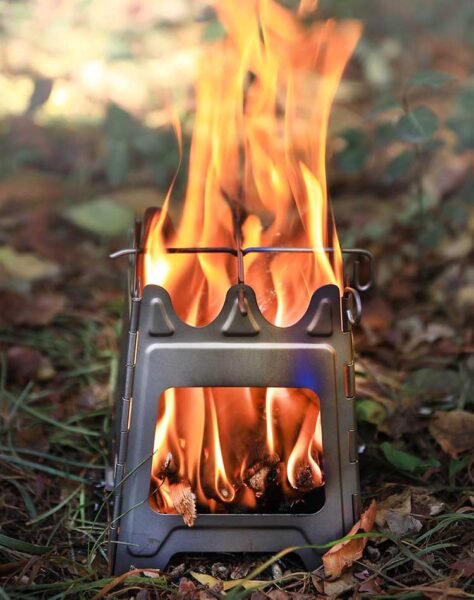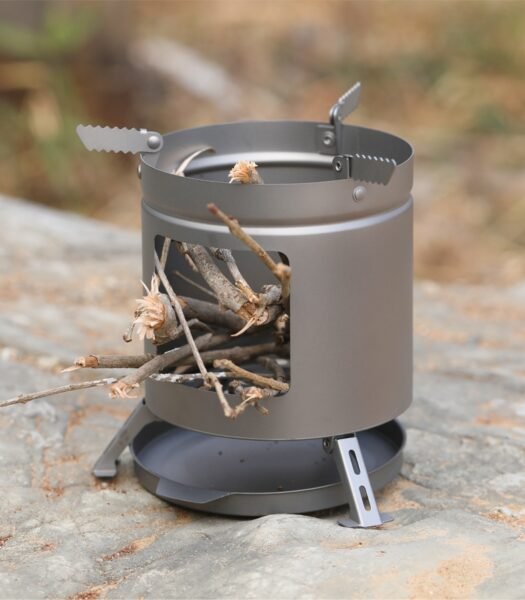A wood stove is suitable for a variety of outdoor scenarios, such as camping, hiking, and backpacking. Whether you’re cooking meals, boiling water, or simply keeping warm, the right stove ensures convenience and enhances your outdoor experience. Here’s a guide to help you choose the perfect wood burning stove for your next adventure.
1. Stove Structure
The structure of the wood stove should be simple, stable, and easy to install and remove. There are two main types of stoves: built-in and portable.
- Built-in stoves: These are fixed in tents or campers. They are large, provide a stable heat source, and are ideal for long-term use. However, they are not convenient to move.
- Portable stoves: These stoves can be folded and stored easily, making them ideal for backpacking and camping. While they are lightweight and easy to carry, their combustion efficiency is generally lower compared to built-in stoves.
For activities like hiking or backpacking, an ultralight wood stove or a titanium wood stove is a great choice due to their portability and durability.
2. Material Selection: Advantages and Disadvantages
Choosing the right material for your wood stove is crucial, as it impacts weight, durability, and performance. Below are the common materials:
- Stainless Steel: Corrosion-resistant and high-temperature resistant, making it suitable for all camping scenarios, especially regular or long-term camping. It is moderately heavy and shows discoloration after burning.
- Aluminum Alloy: Lightweight with good heat transfer. However, it has a shorter lifespan and is less strong than stainless steel.
- Titanium: Extremely lightweight and highly corrosion-resistant. It’s ideal for backpacking and long-distance hiking but comes with a higher price tag. A titanium wood stove is a popular choice for ultralight enthusiasts.
- Cast Iron: Durable with excellent combustion effects. It retains heat well and is resistant to deformation. However, cast iron stoves are heavy and best suited for campsite or car camping.
- Carbon Steel: Strong and affordable but requires rust-proof maintenance. It’s suitable for occasional campers on a budget.
- Cold Rolled Steel: Low-cost but prone to rust. Proper maintenance is essential, and it’s best for short-term or occasional camping.
Choose a material that matches your activity and durability requirements. If you’re car camping, portability might be less critical, and you can choose sturdier, larger models. For hikers and backpackers, portability is crucial for outdoor activities. They normally look for lightweight stoves that are easy to pack and carry. Foldable stoves are excellent for saving space. Although the price is higher than other materials, but investing in a quality stove often pays off in durability, efficiency, and safety.
3. Check Efficiency and Fuel Usage
Efficient stoves consume less wood and produce less smoke, which benefits both the environment and your experience. Look for designs that:
- Maximize airflow and heat output.
- Minimize fuel consumption.
- Include features like larger combustion chambers for extended burn times.
A well-designed backpacking wood stove ensures you use less firewood while enjoying reliable heat and cooking performance.
4. Safety Performance and Environmental Considerations
Safety is paramount when choosing a wood stove. Look for the following features:
- Stable legs: To prevent tipping and ensure stability.
- Heat shields: To protect surrounding areas from heat damage.
- Proper ventilation: To avoid smoke buildup.
- Ash pans: For easier cleanup and to support the Leave No Trace principle.
Testing your stove at home or in a controlled environment before your trip ensures you are familiar with its setup, operation, and safety protocols.
5. Final Considerations
When selecting a wood burning stove, consider these factors:
- Purpose: Are you camping, hiking, or backpacking?
- Number of People: Ensure the stove meets the needs of your group size.
- Portability: For activities like backpacking, an ultralight or foldable wood stove is ideal.
- Budget: Titanium and stainless steel stoves are pricier but often worth the investment for durability and efficiency.
The right stove makes all the difference in your outdoor adventures. Whether it’s an ultralight wood stove for long hikes or a sturdy built-in stove for base camping, choose one that fits your needs and enhances your outdoor experience.Use your wood stove responsibly, leave no trace, and minimize your environmental impact. This ensures that future generations can enjoy nature’s beauty just as much as you do.
#Campingandbackpackingessentials#ultralightstove#titanium wood stove


